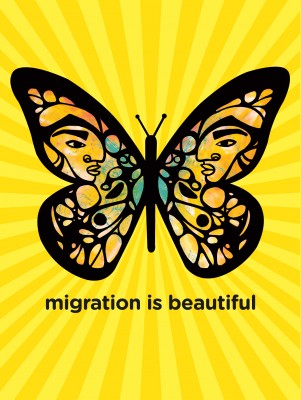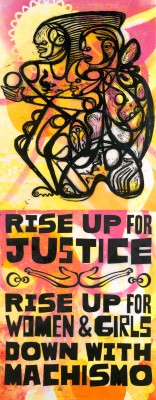The renowned Black feminist poet, theorist, and activist Audre Lorde once said, “There is no such thing as a single-issue struggle because we do not live single-issue lives.” This is exactly what the art, politics, and voice of Favianna Rodríguez represent.
The daughter of Peruvian migrants to the United States, Favianna, 36, is a force to be reckoned with. She is relentlessly active in a myriad of struggles: migrant, women's, LGBT rights, racial, class, environmental, and food justice. The list is endless and alive, growing by the day. Above everything, though, she is an artist—a calling that encompasses all that she believes in and lives for.
Favianna spoke with Global Voices via Skype from her home in Oakland, California. Her smile is warm, and her tone is urgent. She does not have much time to spare, nevertheless she is generous and engaged. We talked about her life, her art, and her politics.
Global Voices (GV): ¿Cómo te nació la consciencia? Do you remember a particular moment? I always remember this phrase from the title of Rigoberta Menchú’s biography. A possible translation is “when was your conscience born,” which does not really convey the same meaning as in Spanish.
Favianna Rodríguez (FR): I grew up in a migrant family, my family is from Perú, I am first generation. I would notice there would be a lot of racism directed at my parents. At a young age I was acting as a translator for my parents. I always felt that we were outsiders. When we moved to a Latino community, I didn’t feel this so much, but when we moved, it was extremely evident. I had curly hair, I was different, I never felt I belonged.
When I went to high school I started organizing around Latino issues. They would talk to me about racism and how young Latinos were viewed as gangsters. The narrative about my fellow peers was always very negative. Then I started learning about the Mayas, the Aztecs, and the contributions of so many Latinos to the United States. We organized the day of Latino students, I founded the first Latino club in my high school. This was also at the time of Proposition 187, the first time that a state had introduced an anti-migrant piece of legislation. It was horrible. When I began to understand systemic racism, it changed my whole worldview.
It was a combination of living in a very anti-Latino time (the 1990s), but also finding the power of collective action that helped me learn love myself. I began to learn our history. I didn’t feel part of the fabric of this country, and yet we were. I hadn’t learned how much economically we shaped this country.
GV: Do you think that anti-Latino climate in the US has changed?

Favianna Rodríguez.
FR: What I think has changed is that we have built a political culture, but we are still very invisible.
GV: Your art and politics combine migration rights, women’s rights, feminism, sexual rights, LGBT rights, environmental justice, racial justice, class justice, and more. Can social justice activism ever choose and select issues?
FR: First, in many ways I am responding to issues that have affected me as a human being, a migrant, a woman, having had an abortion, being a woman of color in the art world, I live these experiences in my work and art. We experience life in a very different way. What I create is a reflection of a different experience, what white men create is another experience. There is a value from creating that stems from lived experiences. I grew up seeing how immigrants diets changed as soon as they came to the US, for example, this made me realize that all of this was connected, food, labor, capitalism, women.
Art has the power to do all of this because art by nature is intersectional. Politics tend to be fragmented, directed at particular people, and to me art is about life. When you are an art maker, a musician, you are not looking to tell the story of one person, but of human beings. On the other hand, political organizing can be very specific. I think I am able to easily move between worlds because I am an artist, and I am not attached to a particular issue. I combine narratives.
GV: One of the themes that runs through your art and politics is eradicating taboos on women’s sexuality, and recognizing the power and beauty of sexuality. What are the intersections between sexuality and sexual rights and other forms of activism, such as migration rights and environmental justice?
FR: I’ve come to the realization that liberation begins with our bodies. We need complete control and autonomy over our bodies. The core of our independence is to have governance over our bodies. We are living in a time in which women’s bodies are being more and more discussed in politics, and abortion rights are being taken away, there is a real threat to our autonomy. Love and relationships are at the center of how we build our societies, and if we do not have a feminist view of how to build societies, with women and girl’s autonomy and freedom at the center, we cannot build a better world. Sex trafficking, for example, is one of the industries of most growth in the world. There is a belief that women’s bodies can be sold and objectified. If you look at Juarez, and other contexts of massive violence against women, the core is the exploitation of women’s bodies. This is why any transformation must put women’s sexual rights at the center.
In Latin America this is a priority. They are at the front line, they don’t call it reproductive rights, but sexual justice. This is not about reproduction but about sexual and gender justice. There is a stereotype that Latin American women are repressed, and that is not true. They include sexual workers in their feminist activism, and that is really important.
GV: How do you identify yourself? Do you feel the need to identify yourself?
FR: I identify myself as an artist, first and foremost, before I say I am a woman. Because for me art is being a critical thinker. I think women’s and immigrant issues are issues of humanity, and even though I embrace that, I actually want to be seen as an artist. Gender can also be like a jail. I hate that when I do street art I have to be mindful of my surroundings, be careful, and I don’t like that some things are associated with my gender. Artists are risk takers and truth speakers. My calling in life is to create. And artists should be challenging the status quo.
GV: I have discovered a powerful online movement of immigrants in the United States who make art, particularly through printmaking. Is there a historical tradition of this in the US? Do you think there is a “boom” at the moment of migrant political art in the US?
FR: Yes, absolutely, and believe it or not one of the most powerful printmaking tradition comes from Puerto Rico, and also Mexico and Cuba. I think printmaking is so powerful because it allows for multiplicity. In the 60s and 70s it was art in the service of liberation and education. The “Taller de Gráfica Popular” in Mexico was all about the creation of the multiple, moving away of valuing one work of art, and instead thinking that art should be distributed and shared. I would call it the art of the multiple, and now it also lives in the online world.
GV: How has the Internet contributed to your activism and art?
FR: My evolution as an artist began because of the Internet. In those very first days, adobe photoshop 1.0 and Illustrators gave me a whole set of new tools to create. I realized that I could have my work on a page for the whole world to see. The Internet was an open space to have your content and connect with the world. Also the DIY [Do It Yourself] culture really helped. I was able to learn so much. It totally shaped how I do my work, I believe in technology as an important part of my work.










1 comment